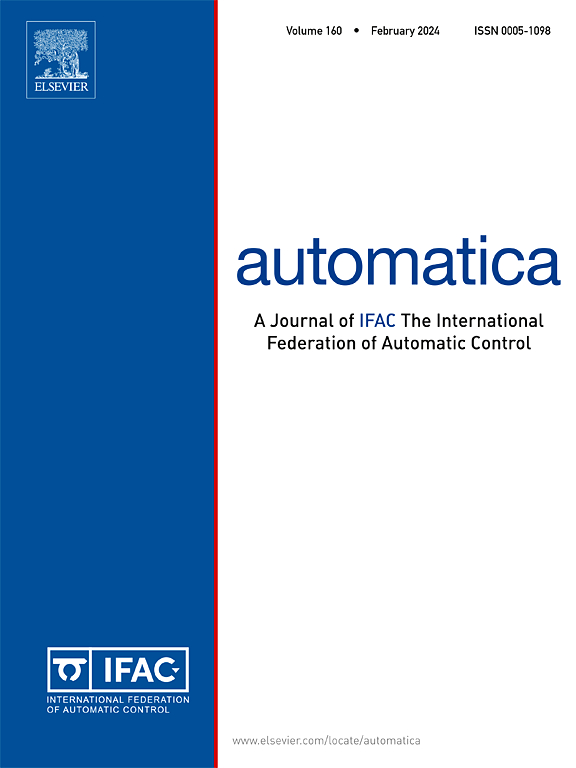变分不等式的任意解:(递归)安全单调流
IF 4.8
2区 计算机科学
Q1 AUTOMATION & CONTROL SYSTEMS
引用次数: 0
摘要
本文以连续时间动力系统的形式,综合了求解单调变分不等式的任意算法。我们介绍了三种解决这一问题的算法:投影单调流、安全单调流和递归安全单调流。前两种系统允许双重解释:要么是投影动力系统,要么是由使用安全临界控制技术导出的二次规划指定的反馈控制器控制的动力系统。第三种流动绕过了沿着轨迹求解二次程序的需要,通过结合动力学,其平衡精确地对应于这些解决方案,并在不同的时间尺度上连接动力系统。我们对这三个系统的动力学特性进行了全面的分析。对于安全单调流,我们证明了平衡点与原问题的临界点精确对应,并且约束集是前向不变和渐近稳定的。通过对系统的凸性和单调性的附加假设,得到了系统全局稳定性的保证,并建立了约束集为多面体时系统的收缩性。对于递推安全单调流,利用收缩系统奇异摄动理论的工具证明了KKT点是局部指数稳定和全局吸引的,并得到了实际的安全保证。我们在一个二人博弈的例子上说明了流的性能,并在一个后退视界线性二次动态博弈的例子中证明了安全单调流的动态过程的互联和调节的通用性。本文章由计算机程序翻译,如有差异,请以英文原文为准。
Anytime solvers for variational inequalities: The (recursive) safe monotone flows
This paper synthesizes anytime algorithms, in the form of continuous-time dynamical systems, to solve monotone variational inequalities. We introduce three algorithms that solve this problem: the projected monotone flow, the safe monotone flow, and the recursive safe monotone flow. The first two systems admit dual interpretations: either as projected dynamical systems or as dynamical systems controlled with a feedback controller specified by a quadratic program derived using techniques from safety-critical control. The third flow bypasses the need to solve quadratic programs along the trajectories by incorporating a dynamics whose equilibria precisely correspond to such solutions, and interconnecting the dynamical systems on different time scales. We perform a thorough analysis of the dynamical properties of all three systems. For the safe monotone flow, we show that equilibria correspond exactly with critical points of the original problem, and the constraint set is forward invariant and asymptotically stable. The additional assumption of convexity and monotonicity allows us to derive global stability guarantees, as well as establish the system is contracting when the constraint set is polyhedral. For the recursive safe monotone flow, we use tools from singular perturbation theory for contracting systems to show KKT points are locally exponentially stable and globally attracting, and obtain practical safety guarantees. We illustrate the performance of the flows on a two-player game example and also demonstrate the versatility for interconnection and regulation of dynamical processes of the safe monotone flow in an example of a receding horizon linear quadratic dynamic game.
求助全文
通过发布文献求助,成功后即可免费获取论文全文。
去求助
来源期刊

Automatica
工程技术-工程:电子与电气
CiteScore
10.70
自引率
7.80%
发文量
617
审稿时长
5 months
期刊介绍:
Automatica is a leading archival publication in the field of systems and control. The field encompasses today a broad set of areas and topics, and is thriving not only within itself but also in terms of its impact on other fields, such as communications, computers, biology, energy and economics. Since its inception in 1963, Automatica has kept abreast with the evolution of the field over the years, and has emerged as a leading publication driving the trends in the field.
After being founded in 1963, Automatica became a journal of the International Federation of Automatic Control (IFAC) in 1969. It features a characteristic blend of theoretical and applied papers of archival, lasting value, reporting cutting edge research results by authors across the globe. It features articles in distinct categories, including regular, brief and survey papers, technical communiqués, correspondence items, as well as reviews on published books of interest to the readership. It occasionally publishes special issues on emerging new topics or established mature topics of interest to a broad audience.
Automatica solicits original high-quality contributions in all the categories listed above, and in all areas of systems and control interpreted in a broad sense and evolving constantly. They may be submitted directly to a subject editor or to the Editor-in-Chief if not sure about the subject area. Editorial procedures in place assure careful, fair, and prompt handling of all submitted articles. Accepted papers appear in the journal in the shortest time feasible given production time constraints.
 求助内容:
求助内容: 应助结果提醒方式:
应助结果提醒方式:


